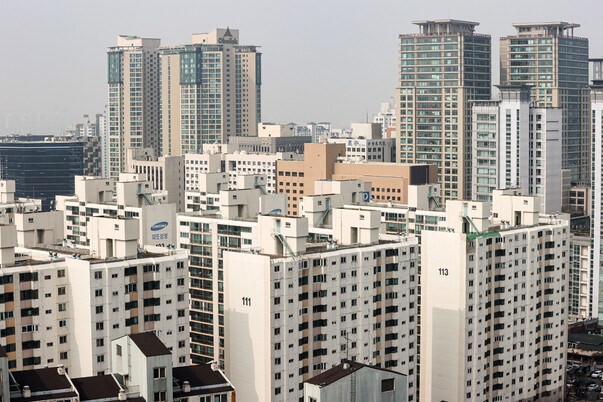Share of housing in Seoul exceeding 600 million won 20.9%→29.4%
Sejong’s median price of 432 million won, ranked 1st in the country

The area of Gongdeok-dong, Mapo-gu, Seoul, where apartment houses are concentrated. yunhap news
The official price of apartment houses nationwide this year rose 19.08% compared to last year. It is the highest rate of increase since 2007. Sejong, which overheated the real estate market last year due to issues such as the relocation of the National Assembly, was the highest in the country at 70.68%. Sejong also surpassed Seoul in the median price of apartment houses and ranked first in the country. Despite the soaring public price, the property tax is expected to be reduced or exempted by applying the special property tax rate for houses under 600 million won, which account for 92.1% of the nation’s apartment houses. On the 15th, the Ministry of Land, Infrastructure and Transport unveiled the ‘2021 public housing price plan’ for 14.25,000 apartment units nationwide, such as apartments, multiple households, and alliances. This year, the official price of apartment houses nationwide rose 19.08% on average compared to the previous year, reaching the highest level in 14 years following 2007 (22.7%). This is more than three times the increase rate of 5.98% last year. The published price is calculated based on the December market price of the previous year. The soaring public price was due to the rise in the market price itself due to overheating in the housing market last year. In particular, it is analyzed that the overall rise of mid- to low-end housing prices of around 600 million won, as panic buying (panic buying) appeared, especially among young people. In fact, the rate of increase in high-rise residential areas such as Gangnam-gu (25.57%→13.96%) and Seocho-gu (22.57%→13.53%) in Seoul decreased compared to the previous year, while Nowon-gu (7.16%→34.66%), Dobong-gu (7.05%→26.19%), and Dobong-gu (7.05%→26.19%), In Gangbuk-gu (4.1% → 22.37%), the rate of increase increased significantly. As the market price surge is the main reason for the increase in the quoted price, the rate of actualization of the quoted price (market price reflection rate) rose only 1.2 percentage points (69.0% → 70.2%) from the previous year, even though the quoted price increase rate reached 19.08%. According to the’Public Price Realization Roadmap’ established in November of last year, the realization rate is finally set to reach 90% level by 2030. By city and province, the public price of Sejong rose by 70.68%, showing the highest rate of increase in the country. Sejong’s apartment prices rose the most in the country last year due to issues such as the relocation of the National Assembly. Four locations, including Gyeonggi (23.96%), Daejeon (20.57%), Seoul (19.91%), and Busan (19.67%), also showed higher rates of increase than the national average. Last year, when the real estate economy in 2019 was reflected, the listed prices in nine locations including Daegu, Ulsan, Chungbuk, and Gyeongnam fell from the previous year, but this year, all cities and provinces across the country have posted prices higher than the previous year. When the publicly announced prices of apartment houses nationwide were listed in order of price, the middle price, that is, the median price, was 160 million won. By city and province, Sejong’s median price was 429 million won, surpassing Seoul (380 million won) for the first time, ranking first in the country. Sejong’s median price has nearly tripled in four years from 184 million won in 2017. Gyeonggi-do (280 million won) first rose to 200 million won.

※ Click the image to see it larger.
As the public price soared, the proportion of houses under 600 million won decreased by 60,000 units from 95.1% (13.15 million units) last year to 92.1% (13.10 million units) this year. In Seoul, there was a significant decrease from 79.1% (2 million units) to 70.6% (1.83 million units). As a result, the proportion of homes exceeding 600 million won in Seoul increased from 20.9% (530,000) to 29.4% (760,000) last year. The number of apartment houses that are subject to comprehensive real estate tax payments in excess of 900 million won (US$900 million) surged from 309164 units last year to 52,4620 units this year, of which 78.7% (413,000 units) were in Seoul. According to the roadmap for realization of public prices last year, the property tax special tax rate was created, and houses under 600 million won, which account for 92.1% of the nation’s apartment houses, will receive property tax reduction or exemption. By Jin Myung-sun, staff reporter [email protected]
